A HISTORY OF THE SOMERSET & DORSET 7F 2-8-0.
BY DAVID MILTON.
Now that the ‘Circle’ has decided to investigate the possibility of preserving one of the S&DJR 2-8-0 locomotives I feel that the time is right to look at their history. I propose to do this in three parts, the first being a technical description, the second details of trials and testing and the third a general history.
In the early part of this century the main source of revenue for the S&DJR was the mineral wealth of the Mendip Hills. This consisted of coal from the Radstock area and stone from the Binegar and Shepton Mallet area. In order to move this traffic it is necessary to climb gradients of up to 1 in 50 or to be able to control trains down such gradients. It is no wonder that with locomotives no larger than the moderate-sized 0-6-0s at his disposal, Mr M F Ryan, the S&DJR Locomotive Superintendant repeatedly asked Derby to produce something larger for the line.
As a result of his requests, the Derby drawing office – under the direction of Henry Fowler – designed the now famous 2-8-0 ‘mineral’ locomotives. These were built in two batches the first batch of six being built at Derby in the MR workshops and delivered to the S&DJR in 1914. The Railway Magazine for April 1914 stated that the first of these locomotives, No. 80, arrived at Bath on the 1st March 1914 and the same magazine in December 1914 noted that No. 85, the last of the batch, had now been delivered to Bath.
The locomotives were painted in unlined black and had raised brass numerals on the cab side-sheets. They were the first S&DJR locos to have outside cylinders with Walschaerts valve gear and because of the large diameter of the cylinders these were inclined at an angle of 1 in 12 to clear the platform faces. The lack of suitable turntables meant that the locos would spend a high proportion of their time running ‘tender-first’ and for this reason they were provided with tender cabs and ‘tablet’ exchanging apparatus was fitted to each side of the tenders.
The principal dimensions of Nos. 80-85 were as follows:
CYLINDERS. (2). 21” x 28”
WHEELS.
PONY TRUCK 3ft 3½” dia.
COUPLED. 4ft 7½” dia.
TENDER. 4ft 3” dia.
WHEELBASE.
TOTAL ENGINE. 25ft 9”
ADHESIVE. 17ft 6”
TENDER. 13ft 9”
BOILER.
LENGTH OF BARREL 11ft 11”
MEAN DIAMETER 4ft 9½”
HEIGHT OF CENTRE ABOVE RAILS. 8ft 10”
FIREBOX SHELL.
LENGTH 9ft 0”
WIDTH (at bottom) 4ft 0½”
GRATE AREA 28.4 sq-ft.
TUBES. 149 & 21 o/s dias. 1¾” & 5 1/8”
LENGTH BETWEEN TUBE PLATES. 12ft 3¾”
HEATING SURFACES.
TUBES 1170 sq-ft
FIREBOX 151 sq-ft
SUPERHEATER. 360 sq-ft
BOILER PRESSURE 190 lbs/sq-in.
WEIGHT IN WORKING ORDER.
ON PONY TRUCK. 8T 14c 2q.
TOTAL ADHESIVE. 56T Oc 2q.
TOTAL ENGINE. 64T 15c 0q.
PLUS TENDER. 44T 4c 2q.
TOTAL. 108T 19c 2q
TENDER.
TANK CAPACITY. 3500 galls.
FUEL CAPACITY. 7 tons.
DIVIDED WHEELBASE:
PONY TO FRONT COUPLED. 8ft 3”
FRONT COUPLED TO INTERMEDIATE. 6ft 0”
INTERMEDIATE TO DRIVERS. 5ft 6”
DRIVING TO REAR COUPLED. 6ft 0”
RATED TRACTIVE EFFORT AT 85% BOILER PRESSURE. 35,932 lbs.
Drawings of these locomotives in their original condition were published in the Railway Modeller, February 1967. The official photographs of No. 80 are published in the histories by Robin Atthill and by Barrie & Clinker. These photographs show the locomotive painted in’photographic grey’ with some lining on the cab-side sheets and tender sides and its numerals painted on.
The boilers were of the MR G9AS pattern, similar to those used on the Deeley Compound 4-4-0s and became the standard for the LMS Compound 4-4-0s. They were the straight-topped Belpaire pattern, the barrel being in two rings with the dome on the rear ring. A single pair of Ramsbottom safety valves were provided with a separate, auxiliary, lock up valve behind them. The Schmidt pattern superheater had 21 separate flues in the three rows and a damper which could be set to operate with the regulator.
The damper-operated cylinder was located on the left-hand side of the smokebox. The boiler was superheated at its front end on a saddle casting with a ‘drum’ pattern smokebox having a drum-head tube-plate of larger diameter than the boiler barrel, as in the Deeley 990 class 4-4-0’s.
The outside Walschaerts valve gear had most of its motion rods fluted as were the coupling rods and connecting rods. The fixing of the return crank to the crank-pin was unusual in that four studs were used in place of the more usual square end. This feature became standard LMS practice.
Steam-operated reversing gear was provided, the equipment being mounted within the frames on the right-hand side. Tail-rods were provided for the pistons and Fowler-Anderson bypass valves were fitted to the cylinders to allow free coasting down hills.
Special attention was paid to the brake-gear and three brake cylinders were employed. The three rearward pairs of coupled wheels had brake blocks acting on their front faces operated by two cylinders under the rear drag-plates.
The front pair of coupled wheels had brakes acting on their rear faces operated by a separate cylinder. This cylinder also operated the ‘clasp’ type brakes on the pony truck through a system of rods and levers. Steam sanding gear was fitted with six sand boxes. These applied sand to the front coupled and main driving wheels for forward running and to the rear coupled wheels for reverse running.
For the first year or so of their lives these locos were not allowed to use the sheds at Bath because of two weak bridges at the entrance to the shed ‘roads’. They were shedded at Radstook until the bridges could be strengthened and here it was found that they fouled the shed roof. To overcome this difficulty the upper lip was removed from the chimneys,the domes were flattened and the cab roof ventilators were removed. These latter were replaced by a sliding ventilator which became the prototype for the LMS pattern. Mr. R C Archbutt had now taken over as Locomotive Superintendent and he made a few more modifications by removing the super-heater dampers, in 1916/17, replacing the original screw couplings with three-link ones, fitted shorter buffer-plungers and by substituting gravity hand sanding for the steam sanding gear. One further modification took place in 1919/20 in that the tender cabs were removed. It would seem that the crews found them draughty and preferred to use a tender sheet when running in reverse. Some years later the same critisms were levelled at the tender cabs fitted to B.R. standard locos but this time the draughts were reduced by filling the spaces with sheeting.
In 1922 the LMS provided the S&D with five standard 4F 0-6-0 tender locomotives, Nos. 57-61. Although these were nominally freight locos they were used as ‘mixed freight’ engines on the S & D and with the need for more freight engines it was decided to build a second batch of 2-8-0s.
This second batch of five locomotives (Nos. 86-90) were built by Messrs. Robert Stephenson & Co. Ltd. and were delivered to the S&DJR in 1925.
Their principal dimensions were:
CYLINDERS. (2) 21″ x 28″.
WHEELS.
PONY TRUCK. 3ft 3½” dia.
COUPLED. 4ft 7½”
BOILER.
LENGTH OF BARREL. 11ft 11″.
MEAN DIAMETER. 5ft 3″.
HEIGHT OF CENTRE: ABOVE RAILS 8ft 10″.
FIREBOX SHELL.
LENGTH 9ft 0″.
WIDTH (AT BOTTOM) 4ft 0½”.
GRATE AREA. 28.4 sq-ft.
TUBES. 145 & 27 o/s diameters. 1 7/8” & 5 1/8”
HEATING SURFACE.
TUBES. 1323 sq-ft.
FIREBOX. 148 sq-ft.
SUPERHEATERS 374 sq-ft.
BOILER PRESSURE. 190 lbs/sq-in.
WEIGHT IN WORKING ORDER.
ON PONY TRUCK. 9T 0c 0q.
TOTAL ADHESIVE. 59T 11c 0q.
TOTAL ENGINE. 68T 11c 0q.
PLUS TENDER 42T 14c 0q,
TOTAL. 111T 5c 0q.
TENDER.
TANK CAPACITY. 3500 galls.
FUEL CAPACITY. 5½ tons.
WHEELBASE. 13ft 0″.
RATED TRACTIVE EFFORT AT 85% BOILER PRESSURE. 35,932 lbs.
The first obvious difference from the Derby-built engines was in the boiler, a non-standard type designated G9BS. This was not only larger in diameter, had an increased evaporating and superheating surface area but also was fitted with Ross Pop safety valves in place of the Ramsbottom ones.
The other obvious difference was the provision of a smaller tender of the Fowler LMS standard design with high sides. These tenders had certain items of the water pick-up equipment fitted and could have been fitted for use with water troughs if necessary.
Less obvious changes were the provision of Lambert sanding gear (a French design of wet sanding apparatus fully described in The Locomotive Carriage and Wagon Review, February 1926) and left-hand drive. This latter entailed placing the vacuum ejector and reversing gear on the left-hand side of the locomotive.
The reversing gear was of the hand-operated screw type. Finally, the cab roof was extended back towards the tender to compensate for the lack of tender cabs. These locomotives constituted a slight increase in power over the original batch by virtue of their better weight distribution. The larger boiler gave more weight on the coupled wheels for adhesion and the smaller tender cut down the overall weight. The boiler also had a greater evaporating surface giving better steaming ability although this was later sacrificed for the sake of standardisation.
Further modifications were carried out to the original locos to bring them more in line with the 1925 batch. The steam reversing gear was replaced by hand-operated screw reversing gear and the cab roof was extended back in line with the latter engines.
In 1930, the LMS took the S&DJR locos into its own stock and the 2-8-0s became Nos. 9670-80. The Ramsbottom safety valves on the original batch were replaced by Ross Pop valves, the screw couplings and long buffer spindles were restored and the helmet-shaped covers to the boiler washout plugs on the firebox were removed.
The locomotives were renumbered again in 1932 to leave their numbers vacant for the new Fowler G3 0-8-0s. This time they became Nos. 13800-10. Also in 1932, Nos. 13802 and 13804 were experimentally fitted with KYLALA blast-pipes and larger diameter chimneys. These were removed in 1934.
As previously mentioned, the G9BS boilers on the second batch were non-standard and as spare boilers of this type were used up it was decided to fit the locos with the G9AS boiler. The first locomotive to be so treated was No. 89 which was involved in the accident of November 1929 and returned from Derby rebuilt with a G9AS boiler. This necessitated building up the smokebox saddle to accept the smaller boiler and the distance pieces put in for this purpose could easily be recognised on the locomotive concerned. The firebox of No. 90 developed a fault at about this time and it too had its boiler replaced with one of smaller diameter. It was some years before the next loco had its boiler replaced, 1954 in fact, and the loco concerned was No. 88 (then 53808). This prompted a letter in the Railway Magazine on the subject of the boilers and the interchange of boilers type G9AS with LMS Compound 4-4-0s. It states that Compound 41068 received boiler No. 6287 from 53801 in November 1948. In August 1951, No.53801 was given boiler No. 9772 from a recently scrapped compound No. 41012. The letter concludes by remarking that of the remaining locos with large boilers, 53806 obtained G9BS boiler No. 6252 in August 1951 from 53807, the latter being fitted with G9BS boiler No. 6251. In the summer of 1955, 53806 was the last remaining 2-8-0 with a large boiler and later that year it went to Derby and returned with a G9AS type. At about this time 53807 had its built-up smokebox replaced by a new one built to the original design.
In giving the details of reboilering I have jumped ahead of the rest of the story and we now return to the late 1930’s. Under Stanier, the pony truck brakes were removed and the Fowler-Anderson bypass valves were replaced by standard snifting valves. New chimneys were fitted and for a while the snifting valves were fitted on the footplate above the cylinders but were later returned to their original position. About this time the driving wheels were given new tyres increasing their diameter to 4ft 8½” and reducing the tractive effort to 35,296 lbs. Just before the war, steam sanding gear was fitted to all eleven locos and also double-handled regulators and standard LMS sliding firebox doors.
In 1948, the S&DJR was transferred to British Railways and the locos were renumbered for the last time. In common with all ex-LMS locos they had 40,000 added to their numbers and became Nos. 53800-10. Number 53801 acquired a tender from a scrapped compound 4-4-0 which had a thirteen foot wheelbase and doors to the coal bunker. The last change to be made to these locos was the fitting of asbestos-based brake blocks. Several advantages were claimed for these blocks over the conventional cast iron ones these being, longer life, reduction in wear on the outside motion from brake dust and lastly, they were easier to fit being much lighter than the cast iron blocks.
See also: 53808’s Restoration.
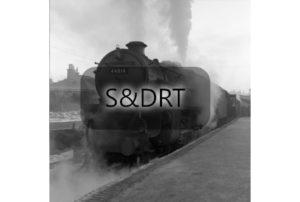 Blandford; Stanier Class 5MT No. 44814 on Down passenger service (2); G A Richardson
1 × £1.50
Blandford; Stanier Class 5MT No. 44814 on Down passenger service (2); G A Richardson
1 × £1.50 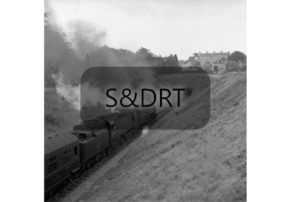 Devonshire Tunnel; 75027 & 34043 'Combe Martin' on Down passenger service, approaching tunnel, July '62 (2); G A Richardson
1 × £1.50
Devonshire Tunnel; 75027 & 34043 'Combe Martin' on Down passenger service, approaching tunnel, July '62 (2); G A Richardson
1 × £1.50 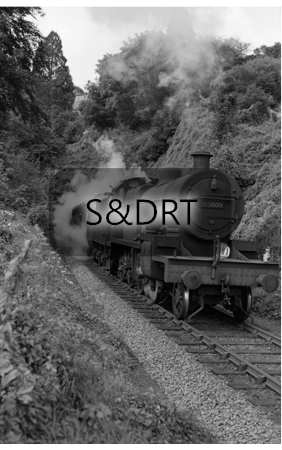 Devonshire Tunnel; 53809 on 1O91 Nottingham-Bournemouth service, exiting tunnel; G A Richardson
1 × £1.50
Devonshire Tunnel; 53809 on 1O91 Nottingham-Bournemouth service, exiting tunnel; G A Richardson
1 × £1.50 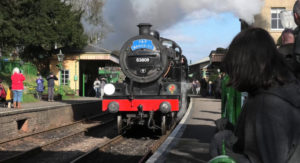 Special event with 53808 - accompanied child ticket
1 × £1.00
Special event with 53808 - accompanied child ticket
1 × £1.00 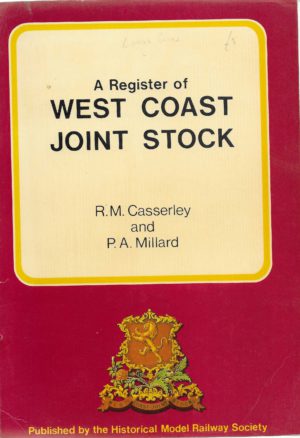 a
1 × £5.00
a
1 × £5.00 